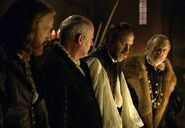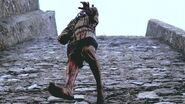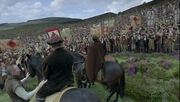
Robert Aske (left) and John Constable at the head of the Pilgrimage of Grace.
The Pilgrimage of Grace is a rebellion against the rule of King Henry VIII that occurred in the first half of Season Three of The Tudors. The rebellion, which began in Yorkshire, was composed of Northern Catholic subjects who were angered by the Dissolution of the Monasteries by the King's First Minister, Thomas Cromwell. This represented the largest open uprising to Tudor rule during Henry's reign (though his children Edward VI and Mary I would also deal with rebellions in their own time) and was a demonstration of the unpopularity and division of his reign, though the rebels incorrectly blamed Henry's advisors rather than the King himself.
Initial actions (3.01-3.02)
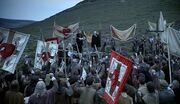
Robert Aske leads 40,000 rebels
With the death of the Protestant Queen Anne Boleyn (episode 2.10) most Catholics abroad and in England assumed the English Reformation was a lost cause, as King Henry himself was never a serious Reformist. However, with Anne's death Henry's first minister, Thomas Cromwell, rose greatly in Henry's favor- and Cromwell was at least as much a Reformist as Anne had been, if not more so. His policy of shutting down monasteries he deemed 'corrupt' and transferring their assets to the Royal Treasury proved popular with King Henry, as it filled his exchequer and allowed him to buy the closer loyalty of many new nobility by selling them lands once owned by the clergy. While this practice helped centralize England's government, it also removed the only functional system of charity in England's countryside. In addition, it provoked widespread resentment among the Catholic population of England. In particular, the Catholic majority in Northern England were furious with the desecration of all they held sacred. Hundreds of peasants began rallying together in protest and collecting arms, declaring that they would defend the abbeys with their own blood.
In York, an ex-soldier named John Constable soon emerged as one of the leading protesters. Knowing that such a rebellious movement needed level-headed, educated leaders to keep it focused and controlled, he sought two of his old friends, Sir Ralph Ellerker and a gentryman and ex-lawyer named Robert Aske. Ellerker willingly joined the movement when offered a leadership position. Aske, however, initially refused; although he too was furious with the sacking of the abbeys and had said as much to the men, he knew that joining a rebellion would be interpreted as treason against the King, to whom he was deeply loyal. Aske finally agreed to take leadership of the rebellion if the protesters met his terms: they would go south only to petition Henry for their religious rights, and they would not raise arms against the King's men unless attacked themselves. The rebels agreed to his terms, and Aske set about organizing provisions, weapons and equipment to be distributed among them for a march south. They dubbed themselves "The Pilgrimage of Grace" based on the banners they carried, which showed the Four Wounds of Christ upon a red heart.
When several of Cromwell's agents attempted to sack abbeys in Yorkshire, they were violently driven off by Aske's rebels; the majority of them were forming up into a formidable army in York, nearly 40,000 strong. A similar attempt to gather rebel forces in Lincoln failed, but the Royal agents and the garrison soon withdrew south as Aske's army marched towards the city.
In London, King Henry was both enraged and frightened; his Royal Army was widely dispersed, and even at its' full strength it was outnumbered by Aske's forces, which had picked up further supporters in Lincolnshire. Henry took out his anger on Cromwell for having supposedly provoked the Pilgrimage, ordering him to salvage the situation or pay the ultimate price. Henry then named his best friend Charles Brandon, the Duke of Suffolk, as Commander of the Royal Army, and ordered him to move north and halt the Rebel force at any cost. Charles took the task without hesitation, but he knew he had little chance of success; indeed, due to his hatred for Cromwell, he was actually hoping that he would fail, and Henry would finally dispose of his hated rival.
Negotiating (3.02-3.03)
The Pilgrimage forces moved south quickly, aiming for the castle of Pontifract. Even using desperate measures, there was no way for Charles to mobilize the Royal Army fast enough too intercept them; most of the soldiers were too far south and dispersed.
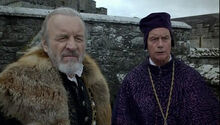
Lord Darcy (left) resolves to negotiate with the Pilgrimage rather than defend Pontifract
Lord Thomas Darcy, the castellan of Pontifract, wrote Henry pleading for permission to abandon the castle and retreat south, as he lacked the men and ammunition to even put up a significant fight to keep the castle out of rebel hands; however, Henry refused. Against the advice of a Protestant archbishop who was also at Pontifract, Darcy resolved to negotiate with the leaders of the Pilgrimage, who by then had arrived at Pontifract and were preparing to encircle it.
Second rebellion and reprisals (episodes 3.03-3.04)
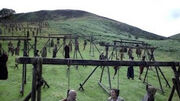
Henry's vengeance against the Pilgrimage
